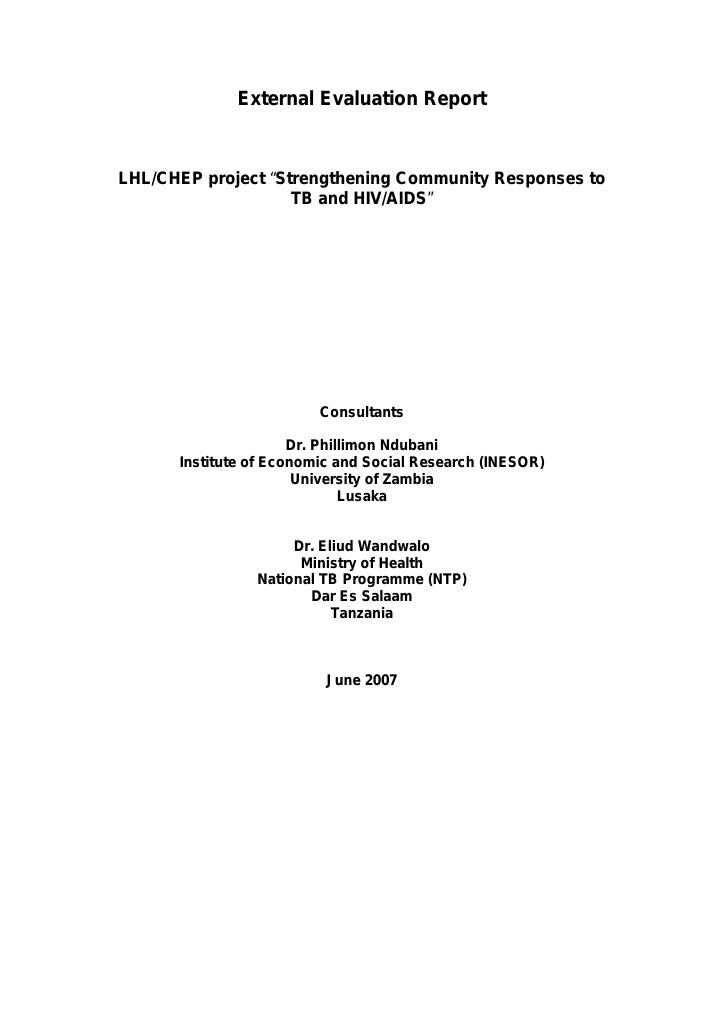Evaluering
Strengthening Community Response to TB and HIV/AIDS – an external evaluation report
Background The Norwegian Heart and Lung Patient Organization (LHL) entered into a three years agreement (2004-2006) with CHEP to implement a program that would strengthen community response to TB and the co-infection of TB and HIV. The project was implemented in the context of high poverty levels and disease burden in the Copperbelt province, Zambia. Due to the overall decline in the economic performance, over the last 10 years or so, poverty levels have increased with over 70 percent of the population living on less than US$1 per day in 2005. In 2005, World Health Organisation (WHO) ranked Zambia among top 10 countries in the World with highest incidence of TB. Purpose/objective LHL/CHEP commissioned two consultants to independently undertake the evaluation of LHL/CHEP Project "Strengthening Community Responses to TB and HIV/AIDS". The essence of the external evaluation was to have an independent review of the implementation of the project in order to assess achievements of the stated objectives, identify challenges so as to come up with appropriate recommendations. Methodology The external evaluation was conducted in four districts on the Copperbelt: Kitwe; Chililabombwe; Masaiti; Lufwanyama. Data was collected through the review of key project documents, key informant interviews, Focus Group Discussions (FGDs) and unstructured observations. Key findings The project was successfully implemented following national and international standards and guidelines. Yearly technical support visits by LHL helped ensure that the project was on course. The evaluation found that the project has achieved its objectives and goals by implementing its planned activities in the four districts. Although TB case detection has not decreased in the four districts, the project has contributed to the improvement of treatment outcomes. The project aimed at building capacity to control the dual TB and HIV epidemic. Capacity building was done in the form of training of community members as treatment supporters. The training was conducted in collaboration with DHMT and other stakeholders using national guidelines and curricula. The Involvement of former TB patients as TB treatment supporters is recommendable and is inline with the national policy of community participation. However, the involvement of family members was low and the project needs to strengthen the role of family members in the provision of DOTS in order to lessen the burden of treatment supporters who have to travel long distance to supervise DOT daily. IEC was one of the core elements of CHEP TB project intervention even though CHEP did not develop a clear strategy to facilitate effective implementation. Recommendations • LHL/CHEP should maintain its strategy of strengthening community response on TB and HIV. The focus should continue to be on building capacity of community groups with attention to former TB patient groups and strengthening their institutional capacity.• While CHEP has done tremendously well in building the capacity of treatment supporters on DOT, and in exceptional cases, the supporters can perform the role of a care giver, family members need to be mobilised and educated to ensure that they are involved in their relatives' treatment.• Since (IEC) ACSM is the core intervention for CHEP TB project, there is need to develop an ACSM strategy with clear goals and targets for the implementation.• LHL/CHEP should maintain database of TB patients notified and treated in the project areas whilst building the capacity of its staff in collection and analysis of the data and use the information in planning and monitoring of the project.• Training of all the players including CBOs should be based on needs assessment for relevance and cost effectiveness. The needs assessments should be conducted at the end of each phase of the project circle in order to feed into the next set of strategies and planned activities.• There should be proper documentation of all community-based activities and capacity for community-based information systems should also be built.• LHL/CHEP should develop guidelines and manual for formulation and mentoring of CBOs. This should be based on well documented relevant experiences of the processes and outcomes.• Best practices within the processes of establishing and mentoring of former TB patient and traditional healers CBOs should be well documented for replication and also for sharing with other organizations working with communities in TB and other diseases.• The cooperation between the DHMTs and LHL/CHEP should be governed by formal arrangements that spell out roles and responsibilities. A Memoranda of Understanding (MoUs) should be developed and signed by both parties as a way of formalising the partnerships.• Whilst the project has empowered communities with knowledge and skills and also assisted them to build enduring community structures, financial sustainability strategies must equally be built into the project at the design stage. With better insights gained over the last three years, CHEP/LHL needs to explore ways of gradually linking-up community based groups to micro-financing institutions for financial sustainability. Comments from the organisation The findings and recommendations have not been surprising, but confirms the strengths and weaknesses in the project. A new 3 year contract is in place, and we have had good and profound discussions on the way forward with background in the findings and recommendations from the review. The project needs to increase the quality of training and will expand to 3 more districts this period. A Memorandum of Understanding (MOU) with the National TB Programme (NTLP) is in process, to secure sharing of information and mutual understanding of interventions from national level. Link to full report: http://www.lhl.no/portal/page?_pageid=513,189797&_dad=portal&_schema=PORTAL&sectionId=1872
